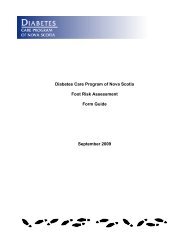2009-10 Annual Report - Central East Local Health Integration ...
2009-10 Annual Report - Central East Local Health Integration ...
2009-10 Annual Report - Central East Local Health Integration ...
Create successful ePaper yourself
Turn your PDF publications into a flip-book with our unique Google optimized e-Paper software.
Identify strategies to provide access to "Primary Care" to those with no doctor - completed<br />
The Unattached Patient <strong>Health</strong> Assessment and Referral Centre (UPA) was created to provide people without<br />
access to a regular primary health care provider (an unattached patient) with access to screening for risk,<br />
assessment for disease and as needed, referral/triage to existing community health and/or specialist resources.<br />
This new service helped individuals understand their health conditions and get access to the care they need to<br />
manage their health. The service was not considered a replacement for on-going comprehensive primary care.<br />
In partnership with the CCAC <strong>Health</strong> Care Connect program, referral to a permanent primary care provider<br />
was facilitated for many patients.<br />
The first Unattached Patient <strong>Health</strong> Assessment and Referral Centre Clinic opened in Bethany in September<br />
<strong>2009</strong> with expansion to Bobcaygeon, Peterborough Clinic, Peterborough Youth Emergency Shelter, Rouge<br />
Valley Centenary, West Hill Community <strong>Health</strong> Centre and the Scarborough Academic Family <strong>Health</strong> Team.<br />
Results found that more than 30% of patients seen by UPA in rural areas had previously undiagnosed<br />
pathology which includes diabetes, dyslipidemia, COPD, cardiovascular disease, melanoma, metabolic<br />
syndrome, osteoporosis and hypertension.<br />
Mental <strong>Health</strong> and Addictions<br />
Addiction Environmental Scan - completed<br />
The environmental scan was to assist addiction service providers in the CE LHIN and all organizations<br />
involved in service provision to the addiction and concurrent disorders client populations to engage in<br />
evidence-based planning of addiction services. The scan produced data related to: service needs within<br />
communities; burden of illness related to addictions; addiction; collaboration and integration opportunities<br />
among addiction services, community and hospital based mental health providers and primary care<br />
practitioners (FHT, CHC, hospitals); and, identification of needed addiction services in CE LHIN.<br />
(http://www.centraleastlhin.on.ca/Page.aspxid=94&ekmensel=e2f22c9a_72_206_94_2)<br />
Emergency Department Avoidance Coalition - ongoing<br />
Shared resources and service coordination is a key component of delivering quality mental health and<br />
addictions services. The Emergency Department Avoidance Coalition was a new initiative that was formed<br />
using Pay for Results funding. The purpose was to create an integrated system of care for people with Mental<br />
<strong>Health</strong> and Addictions issues in Durham. Initial Coalition members included: Lakeridge <strong>Health</strong>, Durham<br />
Mental <strong>Health</strong> Services, CMHA Durham, Rouge Valley <strong>Health</strong> System, Durham Regional Police and Ontario<br />
Shores. One of the major successful outcomes of this Coalition was the implementation of a “new way of<br />
doing business” in Mental <strong>Health</strong> Service delivery that the <strong>Central</strong> <strong>East</strong> LHIN expects to be replicated<br />
throughout the <strong>Central</strong> <strong>East</strong> LHIN area.<br />
Wellness Recovery Action Plan (WRAP) – ongoing<br />
WRAP is a specific education program aimed at building the capacity of people with mental health issues to<br />
manage their own health from a peer perspective. The CE Consumer Survivor Initiative (CSI) Network<br />
submitted a proposal to the CE LHIN to provide WRAP groups to the community. The CE LHIN provided<br />
funding that resulted in over 150 people with mental health issues completing training in the WRAP model.<br />
The WRAP self management tool has been shown to reduce Emergency room visits and improve overall<br />
health outcomes.<br />
Early Intervention for Youth with Mental <strong>Health</strong> and/or Addiction Needs Priority Project – completed<br />
This project was identified as a significant need to deal with the current challenges in transitioning youth<br />
between adolescent mental health and adult mental health services. Unnecessary delays in early identification,<br />
treatment, continuous care planning and the “hand-off” of care from one provider to the next can be the result<br />
of service providers being unable to efficiently respond to transitioning. The Project Team researched<br />
existing strategies for prevention and health promotion and began to establish partnerships across the CE<br />
13

















